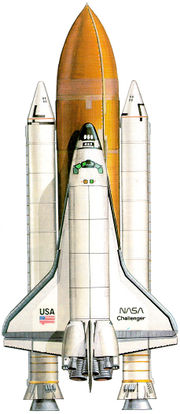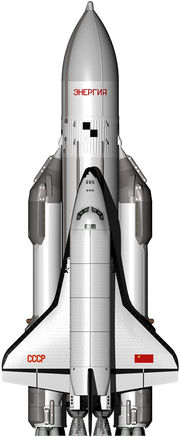Buran (spacecraft)
| Buran Буран |
|
|---|---|
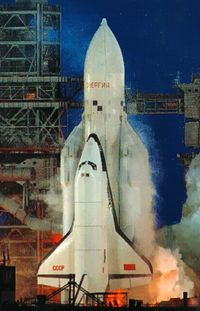 Buran on launch pad 110/37 |
|
| Country | |
| Named after | "Snowstorm"[1] |
| Status | Decommissioned; destroyed in a 2002 hangar collapse |
| First flight | 1K1 15 November 1988[1] |
| Last flight | 1K1 15 November 1988[1] |
| Number of missions | 1[1] |
| Crews | 0[1] |
| Time spent in space | 3 hours |
| Number of orbits | 2[1] |
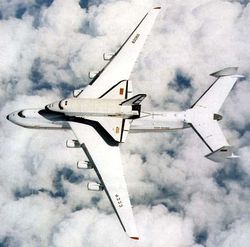
The Buran spacecraft (Russian: Бура́н, IPA: [bʊˈran], Snowstorm or Blizzard), GRAU index 11F35 K1, was the only completed and operational space shuttle vehicle from the Soviet Buran program. The Buran completed one unmanned spaceflight in 1988 before the cancellation of the Soviet shuttle program in 1993. The Buran was subsequently destroyed by a hangar collapse in 2002.[2]
Contents |
Overview
The Buran spacecraft was designed for the delivery to orbit and return to Earth of spacecraft, cosmonauts, and supplies. Like its American counterpart, the Buran, when in transit from its landing sites back to the launch complex, was transported on the back of a large jet aeroplane. It was piggy-backed on the Antonov An-225 Mriya aircraft, which was designed in part for this task and remains the largest aircraft in the world.
First flight
The only orbital launch of Buran occurred at 3:00 UTC on 15 November 1988 from Baikonur Cosmodrome Site 110/37. It was lifted into orbit unmanned by the specially designed Energia booster rocket. The life support system was partially installed and no software was installed to run the computer display screens.[1]
The shuttle orbited the Earth twice in 206 minutes of flight.[3] It performed an automated landing on the shuttle runway at Baikonur Cosmodrome where, despite a lateral wind speed of 61.2 kilometres per hour (38.0 mph), it landed only 3 metres (9.8 ft) laterally and 10 metres (33 ft) longitudinally from the target.[3]
Projected flights
In 1989, it was projected that Buran would have an unmanned second flight in 1993, with a duration of 15–20 days.[4] Due to the cancellation of the project after the break up of the Soviet Union, this never took place. Several scientists have been looking into trying to revive the Buran program, especially after the Space Shuttle Columbia disaster.[5] More recently, the director of Moscow's Central Machine Building Institute has said the Buran project will be reviewed in the hopes of restarting a similar manned spacecraft design, with rocket test launches as soon as 2015. [6] Russia also continues work on the PPTS but has abandoned the Kliper program, due to differences in vision with their European partners.[7][8][9]
Destruction
On May 12, 2002, a hangar housing Buran in Kazakhstan collapsed, due to poor maintenance. The collapse killed eight workers and destroyed the orbiter as well as a mock-up of an Energia carrier rocket.[10][11][12]
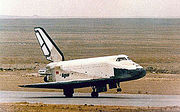
Soviet Space Shuttle Buran landing after its first (and only) space mission
|
See also
- DRAKON
- Mikoyan-Gurevich MiG-105- Soviet orbital spaceplane
- Space Shuttle
- N1 (rocket)
- Spaceplane
- Spacecraft
References
- ↑ 1.0 1.1 1.2 1.3 1.4 1.5 1.6 "Buran". NASA. 12 November 1997. http://liftoff.msfc.nasa.gov/rsa/buran.html. Retrieved 2006-08-15.; Shuttle Buran at the Wayback Machine (archived January 28, 2008).
- ↑ Russianspaceweb.com
- ↑ 3.0 3.1 Chertok, Boris (2005). Asif A. Siddiqi. ed (PDF). Raketi i lyudi (trans. "Rockets and People"). NASA History Series. p. 179. http://ntrs.nasa.gov/archive/nasa/casi.ntrs.nasa.gov/20050010181_2005010059.pdf. Retrieved 2006-07-03.
- ↑ "Экипажи "Бурана" Несбывшиеся планы.". buran.ru. http://www.buran.ru/htm/pilots.htm. Retrieved 2006-08-05. (Russian)
- ↑ Birch, Douglas (2003). "Russian space program is handed new responsibility" (url). Sun Foreign Staff. http://www.dailypress.com/sports/nationworld/bal-te.russia05feb05,0,3940646,full.story. Retrieved 2008-10-17.
- ↑ "Russia To Review Its Space Shuttle Project". xinhua. http://www.spacedaily.com/reports/Russia_To_Review_Its_Space_Shuttle_Project_999.html. Retrieved 2010-07-28.
- ↑ "Soviet space shuttle could bail out NASA". Current.com. 2008-12-31. http://current.com/items/89670174/soviet_space_shuttle_could_bail_out_nasa.htm. Retrieved 2009-07-15.
- ↑ "Soviet space shuttle could bail out NASA". Russiatoday.com. http://www.russiatoday.com/scitech/news/33330?gclid=CJSjwpD2qJgCFQEpGgod_jeUnA. Retrieved 2009-07-15.
- ↑ "Russia, Europe abandon joint space project - Roscosmos". RIA Novosti. http://en.rian.ru/russia/20090129/119870166.html. Retrieved 2009-01-29.
- ↑ Whitehouse, David (2002-05-13). "Russia's space dreams abandoned". bbc.co.uk (BBC). http://news.bbc.co.uk/1/hi/sci/tech/1985631.stm. Retrieved 2007-11-14.
- ↑ Buran.ru: Photo of collapsed hangar
- ↑ Buran.ru: Remains of Buran photo with right front windscreen still visible under the debris
Further reading
- Energiya-Buran: The Soviet Space Shuttle, Bart Hendrick and Bert Vis, Springer-Praxis, 2007, pp. 526, ISBN 978-0-387-69848-9.
- Heinz Elser, Margrit Elser-Haft, Vladim Lukashevich: Buran - History and Transportation of the Russian Space shuttle OK-GLI to the Technik Museum Speyer, two Languages: German and Englisch, 2008, ISBN 3-9809437-7-1
External links
- Manufacturer's site about Buran space shuttle, buran.ru.
- Manufacturer - NPO MOLNIYA Research and Industrial Corporation.
- Buran historical photos at NPO MOLNIYA (buran.ru) with comments in Russian.
- Buran video archive at NPO MOLNIYA with comments in Russian.
- Enthusiast site about Buran space shuttle
- Full video briefing of the Buran shuttle
- Buran photo report at Pravda.ru
- Technical Drawing of the Buran
- Historical photos at englishrussia.com
- Encyclopedia Astronautica article
|
|||||||||||||||||
|
||||||||||||
